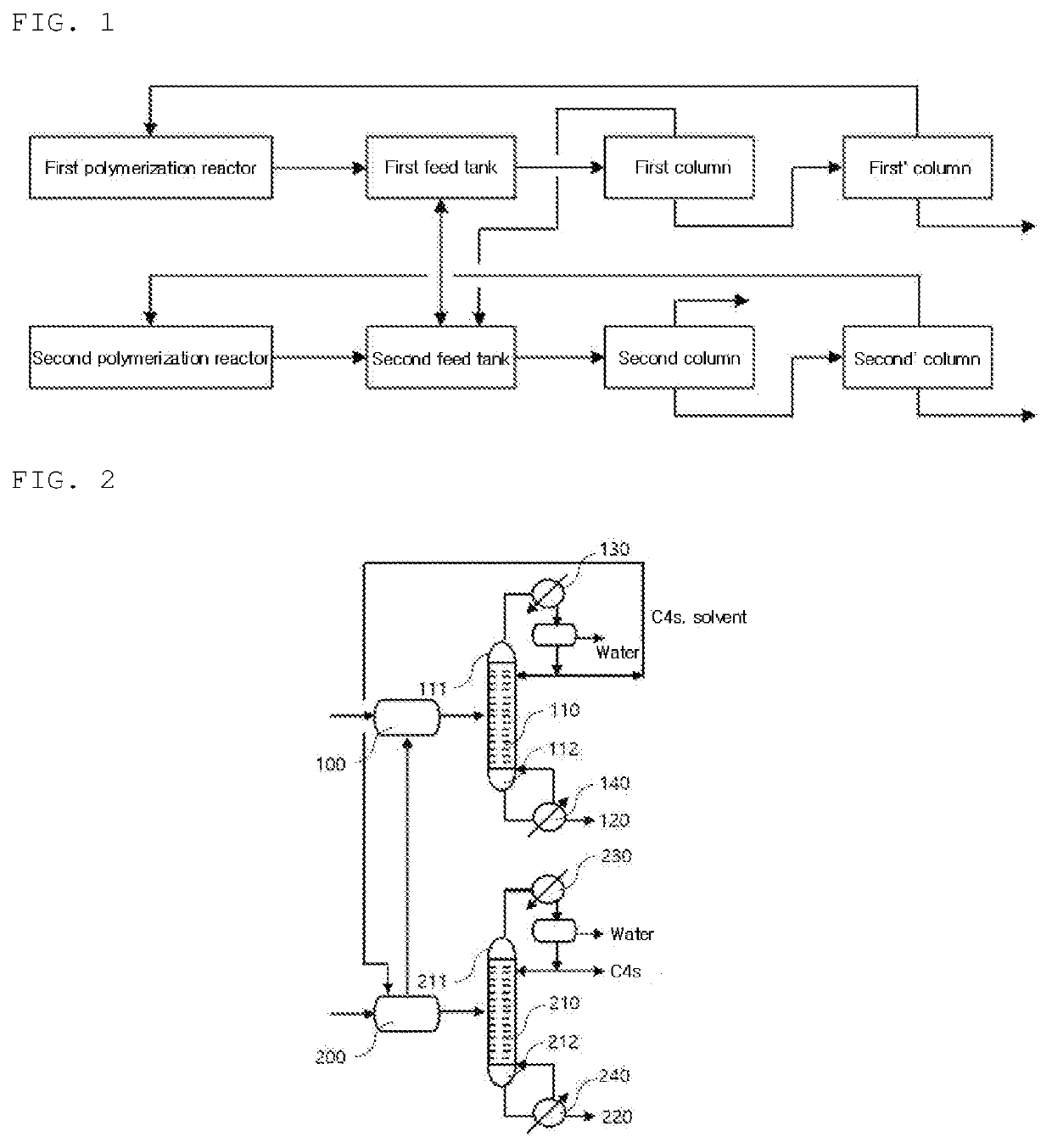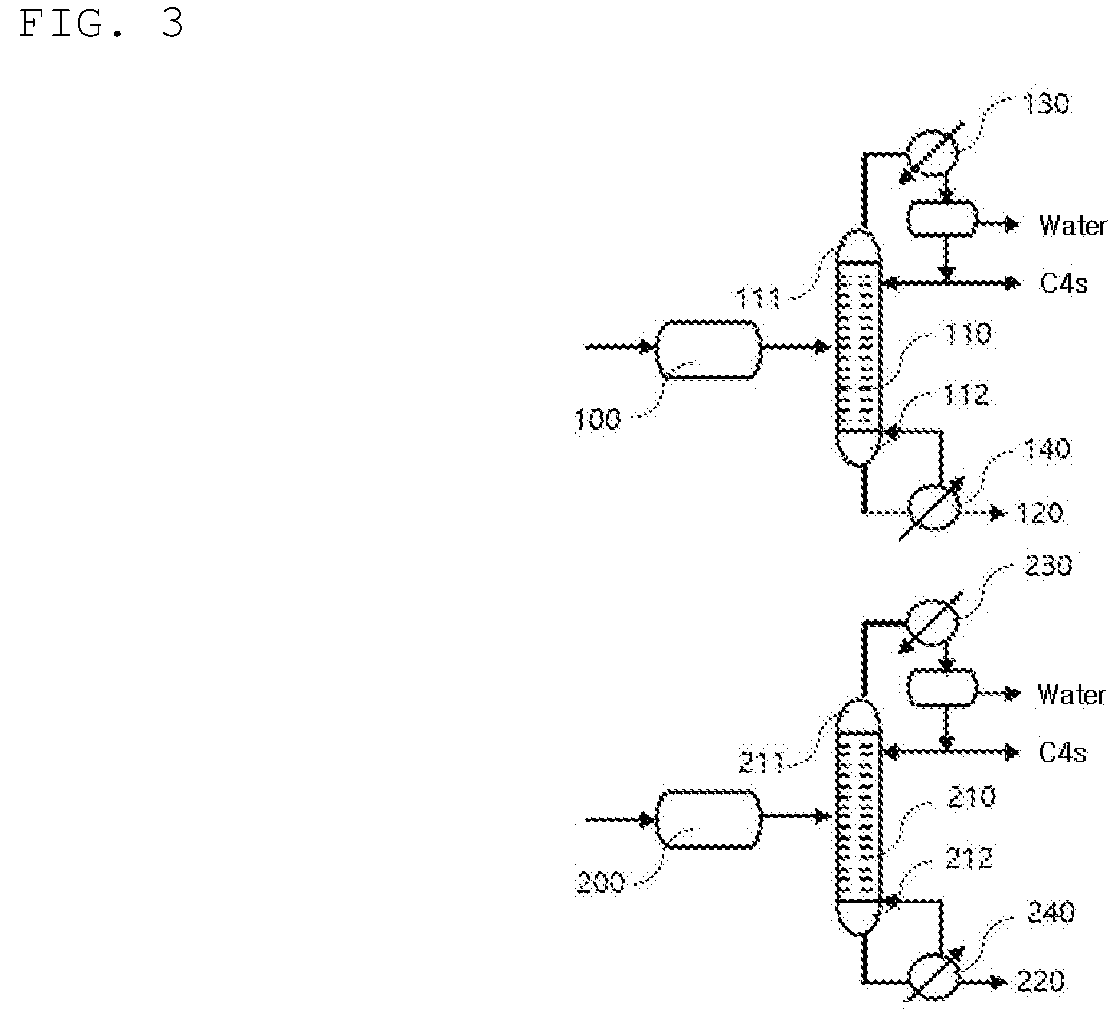Method of Preparing Conjugated Diene-Based Polymer and Apparatus for Preparing Conjugated Diene-Based Polymer
a technology of diene-based polymers and conjugated diene-based polymers, which is applied in the direction of fractional distillation, etc., can solve the problems of increasing investment costs, increasing costs, and reducing production days, so as to prevent side effects in reaction processes, improve the productivity of conjugated diene-based polymers, and prevent solvent loss
- Summary
- Abstract
- Description
- Claims
- Application Information
AI Technical Summary
Benefits of technology
Problems solved by technology
Method used
Image
Examples
example 1-1
[0051]A conjugated diene-based polymer was prepared using the apparatus for preparing a conjugated diene-based polymer as shown in FIG. 2.
[0052]A conjugated diene-based polymer was polymerized in anion solution using n-butyllithium, a styrene monomer, and a 1,3-butadiene monomer, a polymer solution including impurities such as an unreacted 1,3-butadiene monomer, an unreacted styrene monomer, a dimer, butenes, and hexane as a solvent was passed through a stripper and a decanter to recover a first fluid including the solvent and the impurities, and the first fluid was supplied to a first feed tank 100 at a flow rate of 41.4 T / h. An upper condenser 130 of a first column 110 was adjusted to be at a temperature of 49° C. and a pressure of 4.0 barg, and a reboiler 140 was adjusted to be at temperature of 129° C. and a pressure of 4.3 barg. From a tower top 111 of the first column, a fluid including the unreacted monomer and C4s was recovered, which was supplied to the second feed tank 200...
example 1-2
[0055]The same process as in Example 1-1 was carried out, except that in Example 1-1, the temperature of the upper condenser 130 of the first column 110 was adjusted to 53° C., the temperature of the reboiler 140 was adjusted to 131° C., the content of hexane as a solvent in the fluid supplied from the tower top 111 to the second feed tank 200 was adjusted to 20 wt %, and in order to adjust the insufficient amount of the fluid in the first feed tank due to the flow of the fluid, the third fluid was supplied from the second feed tank to the first feed tank at 0.06 T / h.
[0056]Here, an average flow rate of the tower top 111 of the first column 110 was 0.30 T / h, butenes in the stream of the tower bottom 112 was 0.09 wt %, and the moisture content was 15 ppm.
example 1-3
[0057]The same process as in Example 1-1 was carried out, except that in Example 1-1, the temperature of the upper condenser 130 of the first column 110 was adjusted to 55° C., the temperature of the reboiler 140 was adjusted to 134° C., the content of hexane as a solvent in the fluid supplied from the tower top 111 to the second feed tank 200 was adjusted to 30 wt %, and in order to adjust the insufficient amount of the fluid in the first feed tank due to the flow of the fluid, the third fluid was supplied from the second feed tank to the first feed tank at 0.11 T / h.
[0058]Here, an average flow rate of the tower top 111 of the first column 110 was 0.35 T / h, butenes in the stream of the tower bottom 112 was 0.01 wt % or less, and the moisture content was 1 ppm or less.
PUM
| Property | Measurement | Unit |
|---|---|---|
| atomic numbers | aaaaa | aaaaa |
| temperature | aaaaa | aaaaa |
| temperature | aaaaa | aaaaa |
Abstract
Description
Claims
Application Information
 Login to View More
Login to View More - R&D
- Intellectual Property
- Life Sciences
- Materials
- Tech Scout
- Unparalleled Data Quality
- Higher Quality Content
- 60% Fewer Hallucinations
Browse by: Latest US Patents, China's latest patents, Technical Efficacy Thesaurus, Application Domain, Technology Topic, Popular Technical Reports.
© 2025 PatSnap. All rights reserved.Legal|Privacy policy|Modern Slavery Act Transparency Statement|Sitemap|About US| Contact US: help@patsnap.com


